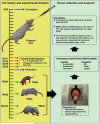Endogenous opioids as substrates for ethanol intake in the neonatal rat: The impact of prenatal ethanol exposure on the opioid family in the early postnatal period
- PMID: 25662024
- PMCID: PMC4484299
- DOI: 10.1016/j.physbeh.2015.02.013
Endogenous opioids as substrates for ethanol intake in the neonatal rat: The impact of prenatal ethanol exposure on the opioid family in the early postnatal period
Abstract
Background: Despite considerable knowledge that prenatal ethanol exposure can lead to devastating effects on the developing fetus, alcohol consumption by pregnant women remains strikingly prevalent. Both clinical and basic research has suggested that, in addition to possible physical, behavioral, and cognitive deficits, gestational exposure to alcohol may lead to an increased risk for the development of later alcohol-related use and abuse disorders. The current work sought to characterize alterations in endogenous opioid signaling peptides and gene expression produced by ethanol exposure during the last days of gestation.
Methods: Experimental subjects were 4-, 8-, and 12-day old infant rats obtained from pregnant females that were given daily intubations of 0, 1, or 2g/kg ethanol during the last few days of gestation (GDs 17-20). Using real-time RT-PCR, western blotting analysis, and enzyme immunoassays, we examined mRNA and protein for three opioid receptors and ligands in the nucleus accumbens, ventral tegmental area, and hypothalamus.
Results: Three main trends emerged - (1) mRNA for the majority of factors was found to upregulate across each of the three postnatal ages assessed, indicative of escalating ontogenetic expression of opioid-related genes; (2) prenatal ethanol significantly reduced many opioid peptides, suggesting a possible mechanism by which prenatal exposure can affect future responsiveness towards ethanol; and (3) the nucleus accumbens emerged as a key site for ethanol-dependent effects, suggesting a potential target for additional assessment and intervention towards understanding the ethanol's ability to program the developing brain.
Conclusion: We provide a global assessment of relatively long-term changes in both opioid gene expression and protein following exposure to only moderate amounts of ethanol during a relatively short window in the prenatal period. These results suggest that, while continuing to undergo ontogenetic changes, the infant brain is sensitive to prenatal ethanol exposure and that such exposure may lead to relatively long-lasting changes in the endogenous opioid system within the reward circuitry. These data indicate a potential mechanism and target for additional assessments of ethanol's ability to program the brain, affecting later responsiveness towards the drug.
Keywords: Ethanol; Ontogeny; Opioids; Protein; Rat; mRNA.
Copyright © 2015 Elsevier Inc. All rights reserved.
Figures

Similar articles
-
Discrete opioid gene expression impairment in the human fetal brain associated with maternal marijuana use.Pharmacogenomics J. 2006 Jul-Aug;6(4):255-64. doi: 10.1038/sj.tpj.6500375. Epub 2006 Feb 14. Pharmacogenomics J. 2006. PMID: 16477274
-
Prenatal ethanol exposure alters met-enkephalin expression in brain regions related with reinforcement: possible mechanism for ethanol consumption in offspring.Behav Brain Res. 2014 Nov 1;274:194-204. doi: 10.1016/j.bbr.2014.08.022. Epub 2014 Aug 19. Behav Brain Res. 2014. PMID: 25150040
-
Maternal manipulation during late gestation (GDs 17-20) enhances ethanol consumption and promotes changes and opioid mRNA expression in infant rats.Behav Brain Res. 2019 Aug 5;368:111908. doi: 10.1016/j.bbr.2019.111908. Epub 2019 Apr 12. Behav Brain Res. 2019. PMID: 30986490
-
Exposure to low and moderate doses of alcohol on late gestation modifies infantile response to and preference for alcohol in rats.Ann Ist Super Sanita. 2006;42(1):22-30. Ann Ist Super Sanita. 2006. PMID: 16801722 Review.
-
A review of the effects of prenatal or early postnatal ethanol exposure on brain ligand-gated ion channels.Alcohol Clin Exp Res. 2000 May;24(5):706-15. Alcohol Clin Exp Res. 2000. PMID: 10832913 Review.
Cited by
-
Subpopulations of hypocretin/orexin neurons differ in measures of their cell proliferation, dynorphin co-expression, projections, and response to embryonic ethanol exposure.Sci Rep. 2023 May 25;13(1):8448. doi: 10.1038/s41598-023-35432-w. Sci Rep. 2023. PMID: 37231149 Free PMC article.
-
Early ontogeny as a unique developmental epoch for learning, memory and consequences of alcohol exposure: A Festschrift to honor the work of Dr. Norman E. Spear.Physiol Behav. 2015 Sep 1;148:1-5. doi: 10.1016/j.physbeh.2015.03.020. Epub 2015 Jun 8. Physiol Behav. 2015. PMID: 26066730 Free PMC article. No abstract available.
-
Advances in Medications and Tailoring Treatment for Alcohol Use Disorder.Alcohol Res. 2015;37(1):15-28. Alcohol Res. 2015. PMID: 26259086 Free PMC article. Review.
-
Neonatal Orally Administered Zingerone Attenuates Alcohol-Induced Fatty Liver Disease in Experimental Rat Models.Metabolites. 2023 Jan 23;13(2):167. doi: 10.3390/metabo13020167. Metabolites. 2023. PMID: 36837786 Free PMC article.
-
Age as a factor in stress and alcohol interactions: A critical role for the kappa opioid system.Alcohol. 2018 Nov;72:9-18. doi: 10.1016/j.alcohol.2017.10.002. Epub 2017 Oct 12. Alcohol. 2018. PMID: 30322483 Free PMC article. Review.
References
-
- Clarren SK, Astley SJ, Bowden DM. Physical anomalies and developmental delays in nonhuman primate infants exposed to weekly doses of ethanol during gestation. Teratology. 1988;37(6):561–569. - PubMed
-
- Driscoll CD, Streissguth AP, Riley EP. Prenatal alcohol exposure: comparability of effects in humans and animal models. Neurotoxicol Tertol. 1990;12(3):231–237. - PubMed
-
- Graham JM, Hanson JW, Darby BL, Barr HM, Streissguth AP. Independent dysmorphology evaluations at birth and 4 years of age for children exposed to varying amounts of alcohol in utero. Pediatrics. 1988;81(6):772–778. - PubMed
-
- Clarren SK, Astley SJ, Bowden DM, La H, Milam AH, Rudeen PK, Shoemaker WJ. Neuroanatomic and neurochemical abnormalities in nonhuman primate infants exposed to weekly doses of ethanol during gestation. Alcohol Clin Exp Res. 1990;14(5):674–683. - PubMed
-
- Arias C, Chotro MG. Increased palatability of ethanol after prenatal ethanol exposure is mediated by the opioid system. Pharmacology, Biochemistry, and Behavior. 2005;82(3):434–442. - PubMed
Publication types
MeSH terms
Substances
Grants and funding
LinkOut - more resources
Full Text Sources
Other Literature Sources
Medical

